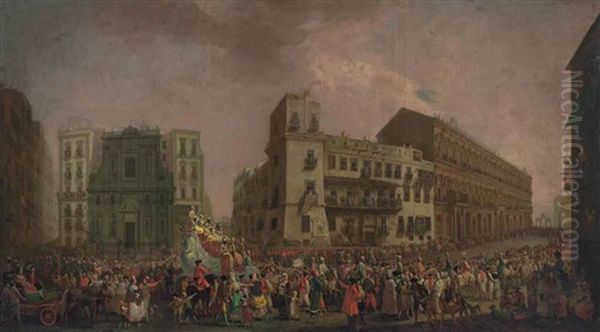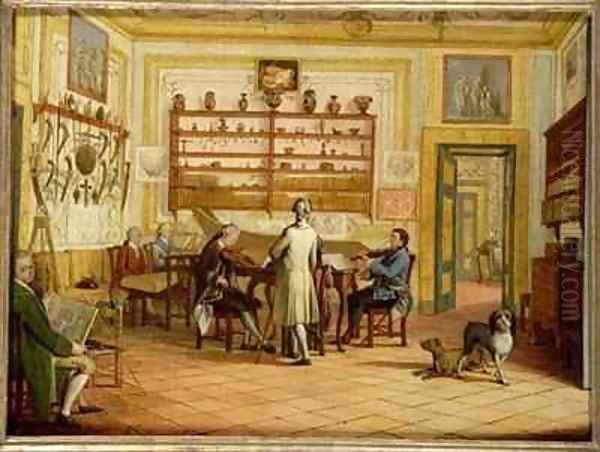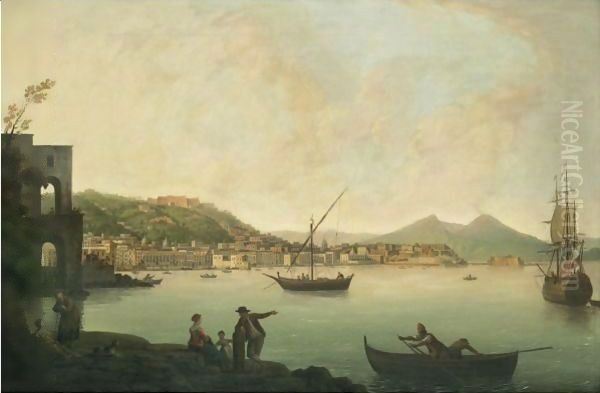Pietro Fabris stands as a significant figure in eighteenth-century Italian art, a painter celebrated for his vibrant depictions of Naples, its dramatic landscapes, bustling city life, and the imposing presence of Mount Vesuvius. Active primarily during the latter half of the century, Fabris captured the unique spirit and visual splendor of this southern Italian metropolis, leaving behind a body of work valued for both its artistic merit and its historical documentation. His paintings, encompassing landscapes, genre scenes, and portraits, are characterized by their bright palettes and meticulous attention to detail.
The exact origins and lifespan of Pietro Fabris remain subjects of some scholarly discussion, adding a layer of intrigue to his biography. While his artistic activity is well-documented in Naples from the mid-1750s onwards, his birthplace is uncertain. Some historical accounts suggest he may have hailed from Venice, a city renowned for its own rich artistic traditions. Others propose Turin as a possible place of origin. Regardless of his roots, Naples became the crucible of his career, the city where he settled around 1754 and developed his distinctive artistic voice.
Further complicating the biographical details are the varying accounts of his active years and lifespan. Some records place his period of activity firmly between 1756 and 1784. However, other evidence, including documented activities and dated works, suggests his career extended later, possibly until 1792. Synthesizing the available information, the most widely accepted timeframe places his birth around 1740 and his death in 1792. This period aligns with the flourishing of Naples as a major center of the Grand Tour, attracting artists and patrons from across Europe.
The Neapolitan Panorama: Landscapes and Daily Life

Fabris excelled in capturing the essence of Naples and its surrounding region. His landscapes are not mere topographical records; they are imbued with the unique atmosphere of Southern Italy. He masterfully depicted the iconic Bay of Naples, the rugged coastline, and the ever-present silhouette of Vesuvius. His canvases often radiate with the intense Mediterranean light, rendered through a characteristically vivid color palette. The details of daily life, the architecture, and the natural environment are rendered with a lively precision that brings the eighteenth-century city to life for the viewer.
Beyond the grand vistas, Fabris demonstrated a keen interest in the people and customs of Naples. His genre scenes offer fascinating glimpses into the social fabric of the time. He painted scenes of peasant festivities, market activities, religious processions, and the vibrant street life that defined the city. These works often capture moments of leisure and celebration, such as depictions of Neapolitans enjoying music or engaging in traditional dances like the Tarantella. Through these paintings, Fabris explored the spectrum of Neapolitan society, sometimes reflecting an aesthetic sensibility that acknowledged both the struggles ("misery") and the inherent dignity ("nobility") of ordinary life.
His ability to blend landscape and human activity is evident in many works. He skillfully integrated figures into his scenic compositions, showing people interacting with their environment, whether they were fishermen on the shore, vendors in a piazza, or elegantly dressed members of the aristocracy enjoying an outing. This holistic approach provided a comprehensive visual narrative of Naples, capturing both its physical beauty and its human energy. His works became highly sought after by visitors on the Grand Tour, eager to take home a memento of their Neapolitan experience.
A Pivotal Collaboration: Sir William Hamilton
A defining aspect of Pietro Fabris's career was his close association with Sir William Hamilton, the British Envoy Extraordinary to the Kingdom of Naples from 1764 to 1800. Hamilton was a man of diverse interests, a diplomat, antiquarian, archaeologist, and notably, a passionate volcanologist fascinated by the nearby Mount Vesuvius. This shared interest in the dramatic natural phenomena of the region forged a strong professional bond between the artist and the diplomat.
Hamilton commissioned Fabris extensively, recognizing the artist's talent for detailed observation and skillful rendering. Fabris became Hamilton's artist of choice for documenting his pioneering studies of Vesuvius and the surrounding volcanic area known as the Campi Phlegraei (Phlegraean Fields). This collaboration proved immensely fruitful, resulting in a unique body of work that merged artistic representation with scientific documentation.

Fabris frequently accompanied Hamilton on his expeditions to Vesuvius, often venturing close to the crater to observe eruptions and geological formations firsthand. These were dangerous undertakings, requiring courage and a steady hand. The resulting artworks provided invaluable visual records for Hamilton's research and publications, capturing the dynamic and often terrifying beauty of volcanic activity with remarkable accuracy and artistic flair. This partnership significantly elevated Fabris's profile, connecting him to the international network of scholars and collectors associated with Hamilton.
Chronicling Vesuvius: The Campi Phlegraei Project
The most celebrated outcome of the collaboration between Fabris and Hamilton was the series of illustrations for Hamilton's seminal work, Campi Phlegraei: Observations on the Volcanoes of the Two Sicilies. Published in Naples between 1776 and 1779, this lavishly illustrated volume contained numerous plates based on Fabris's original gouache paintings. These images documented various phases of Vesuvius's eruptions, the geological features of the volcano and surrounding areas, and even depicted Hamilton and other observers amidst the dramatic landscapes.
Fabris's illustrations for Campi Phlegraei are remarkable for their scientific precision combined with artistic sensitivity. He captured the textures of lava flows, the shapes of craters, the plumes of smoke and ash, and the fiery spectacle of eruptions with meticulous detail. Works such as Vesuvius: Interior of the Crater, showing the little mountain within & spectators (1776) and Vesuvius: Ancient Crater & Changes in its Internal Shape (1776) exemplify his ability to convey complex geological information visually. Another notable piece, Tufa (1776), depicted the tuffaceous hills near the Monte Nuovo crater in Pozzuoli, showcasing his broader interest in the region's volcanic geology.
These gouaches, often hand-colored for the published plates, were more than just scientific records. They possessed a dramatic quality, conveying the sublime power and awe-inspiring nature of the volcanic forces. Fabris managed to capture both the factual details required by Hamilton and the emotional impact of witnessing such events. The Campi Phlegraei illustrations cemented Fabris's reputation not only as a skilled landscape painter but also as a unique contributor to the scientific understanding of volcanology in the eighteenth century. His work provided a visual vocabulary for phenomena that were previously difficult to describe or imagine.
Artistic Techniques and Signature Style
Pietro Fabris was versatile in his choice of media, employing oil paint, watercolor, and etching techniques throughout his career. However, he demonstrated particular mastery in the use of gouache, a type of opaque watercolor. This medium allowed him to achieve the vibrant colors and fine detail that characterize much of his work, especially the celebrated illustrations for Campi Phlegraei. Gouache was well-suited for capturing the specific atmospheric effects and geological textures of the Neapolitan landscape and volcanic terrains.

His style is generally characterized by a commitment to realism and detailed observation. Whether depicting the intricate patterns of lava rock, the specific costumes of Neapolitan figures, or the architectural elements of the city, Fabris paid close attention to accuracy. This precision was particularly valued by patrons like Sir William Hamilton, who required scientifically accurate representations. Yet, Fabris's realism was not dry or merely documentary; it was infused with a sense of liveliness and often dramatic composition.
The use of color was central to Fabris's appeal. He effectively captured the bright, clear light of the Mediterranean, employing a palette rich in blues, greens, earthy tones, and fiery reds and oranges, especially in his volcano scenes. His compositions are often dynamic, leading the viewer's eye through the scene, whether it's a panoramic landscape or a bustling genre painting. This combination of detailed realism, vibrant color, and engaging composition defined his unique artistic signature.
Documenting History and Culture
Beyond landscapes and volcanic studies, Pietro Fabris made significant contributions to the visual record of Neapolitan history and culture. He painted scenes depicting important contemporary events, offering insights into the political and social life of the Kingdom of Naples. One such example is his work illustrating the departure of Charles III from Naples to assume the Spanish throne (likely referencing events around 1759, though the source dates a painting 1757-1758). These paintings served as visual chronicles of moments significant to the Bourbon monarchy ruling Naples at the time.
Fabris also excelled at capturing the pageantry and social rituals of Neapolitan society. His painting Carnival in Naples (1778) is considered a masterpiece of genre painting, vividly portraying the energy and diverse participants of this major public celebration. Similarly, works like The Concert (1769) and Noble Dance and Feast of Neapolitan Dancers in a Park (1763-1776) depict aristocratic leisure and entertainment, showcasing the fashions, manners, and settings of elite Neapolitan life. These paintings provide invaluable documentation of social customs and cultural practices.
His interest in local culture extended to documenting the lives and traditions of ordinary Neapolitans. Fabris contributed illustrations, or edited collections of them, focusing on regional costumes and crafts, such as those for the publication Raccolta di vari vestimenti ed arti del Regno di Napoli. These images detailed the traditional dress of various social classes and occupations within the kingdom, preserving a visual record of folk traditions and everyday life. Through these diverse works, Fabris created a rich tapestry illustrating the multifaceted nature of eighteenth-century Naples.
Connections and Contemporaries in the Art World
Pietro Fabris operated within a vibrant artistic milieu in Naples, interacting with local and foreign artists, patrons, and influential figures. His close relationship with Sir William Hamilton was paramount, providing not only patronage but also access to an international circle. Through Hamilton, Fabris's work gained exposure beyond Italy, particularly in Britain.
The available records indicate specific interactions with other artists. In 1778, Fabris played a role in the personal life of a fellow painter, Francesco Saverio Della Gatta, by arranging and financing his marriage to Antonia Fabris (whose relationship to Pietro is unclear). This suggests a position of some standing within the local artistic community. In the same year, Fabris engaged financially with Vincenzo Cicchetti, contributing a significant sum towards a fund intended to support young artists, indicating a potential role as a benefactor or community leader.
Fabris also had connections with foreign artists visiting or working in Naples. He is known to have been acquainted with the French painter Jean-Baptiste Tierce, who visited Naples in 1776, notably accompanying the Marquis de Sade on his Italian journey. Tierce himself contributed illustrations to travel literature about Italy. Furthermore, Fabris engaged in transactions with prominent British collectors like Charles Townley, who purchased several of Fabris's landscape paintings in 1768, including views of the port of Civitavecchia and the Chiaia area of Naples.
There is also speculation about a possible collaboration or professional relationship with Gabriele Ricciardelli, another painter active in Naples known for his city views (vedute) and work with foreign engravers. While the exact nature of this connection is uncertain, it places Fabris within the network of artists specializing in the popular genre of Neapolitan view painting. His interactions extended to the highest levels of society, including commissions related to the court of King Ferdinand IV, son of Charles III. These connections underscore Fabris's integration into the artistic, social, and diplomatic circles of eighteenth-century Naples.
Exhibitions, Reputation, and Collections
Pietro Fabris achieved recognition both locally in Naples and internationally, particularly in Great Britain, largely thanks to the promotion by Sir William Hamilton. A significant step in gaining wider exposure occurred in 1768 when Fabris exhibited four paintings depicting Neapolitan views at the Society of Free Artists in London. This exhibition, facilitated by Hamilton, introduced his work directly to the British art market and collecting public.
His paintings, especially the landscapes, genre scenes, and volcano depictions, became highly desirable items for Grand Tourists and collectors. His ability to capture the unique allure of Naples and the dramatic spectacle of Vesuvius resonated with the tastes of the time. Consequently, works by Fabris found their way into numerous important private collections across Britain and Europe during his lifetime and afterwards.
Today, Pietro Fabris's paintings are held in the collections of major museums and galleries worldwide. Institutions such as the Metropolitan Museum of Art in New York and various museums in London hold examples of his work. In Naples itself, his paintings are preserved in significant collections, including the Museo Nazionale di San Martino, which houses the notable Noble Dance and Feast of Neapolitan Dancers in a Park. The enduring presence of his work in these public institutions attests to his historical importance and continued artistic appreciation. His reputation rests on his skill as a painter and his unique role as a visual chronicler of a specific time and place.
Controversies and Biographical Uncertainties
Despite his success and lasting reputation, Pietro Fabris's life and work are not without areas of uncertainty and controversy. As previously mentioned, fundamental biographical details like his exact birth and death dates (with sources suggesting activity from 1756-1784, while others support c. 1740-1792) and his place of origin (Venice, Turin, or possibly even Dalmatia) remain debated among art historians. This lack of definitive information adds a layer of complexity to understanding his early life and career trajectory.
Further ambiguity surrounds his potential family connections. Some scholars have suggested a possible kinship with Jacopo Fabris, a notable figure active earlier in the eighteenth century as a scenographer and painter, who also had connections to Naples. However, concrete evidence confirming such a relationship is lacking. These unresolved questions about his background highlight the challenges often faced in reconstructing the lives of artists from this period based on fragmented historical records.
Perhaps more significantly for his artistic legacy, Fabris faced accusations regarding the originality of his work. Some research suggests that certain compositions or motifs in his paintings may have been heavily influenced by, or perhaps even derived from, the works of other contemporary artists active in Naples. While artistic influence and adaptation were common practices, occasional suggestions of outright copying or plagiarism have surfaced in scholarly discussions. These debates, while not definitively resolved, add a critical dimension to the assessment of his oeuvre, acknowledging that even highly regarded artists could be involved in complex networks of artistic exchange and appropriation.
His connections to powerful figures like Sir William Hamilton and the Neapolitan court, including painting costumes for King Ferdinand IV, also place his work within the context of patronage and political dynamics. While these associations undoubtedly boosted his career, they also tie his artistic production to the specific interests and agendas of the ruling elite and influential foreign diplomats.
Legacy and Art Historical Significance
Pietro Fabris occupies a distinct and important place in the history of eighteenth-century Italian art. He was a leading practitioner of Neapolitan view painting (veduta) and genre scenes during a period when Naples was a major European cultural hub and a key destination on the Grand Tour. His works captured the city's unique blend of natural beauty, urban vitality, and dramatic geological phenomena with exceptional skill and vibrancy.
His most unique contribution lies in his detailed and dramatic depictions of Mount Vesuvius and the Campi Phlegraei, executed in close collaboration with Sir William Hamilton. These works stand at a fascinating intersection of art and science, providing invaluable visual documentation for early volcanology while simultaneously functioning as powerful artistic statements about the sublime forces of nature. Fabris effectively became the foremost painter of Vesuvius during one of its most active and closely studied periods.
Beyond the volcano paintings, his broader oeuvre offers a rich visual archive of eighteenth-century Naples. His landscapes, cityscapes, depictions of festivals, folk customs, historical events, and daily life provide precious insights into the society, culture, and environment of the region. He captured the spirit of Naples – its light, its colors, its people – in a way that resonated with contemporaries and continues to engage viewers today.
While questions about his origins and occasional debates about originality persist, Pietro Fabris's overall achievement is undeniable. He was a technically skilled and versatile artist who responded effectively to the demands of his patrons and the market, while also creating a distinctive body of work. He remains a key figure for understanding the art of Naples in the eighteenth century and the broader European phenomenon of the Grand Tour, celebrated for his vivid chronicles of a fascinating city and its fiery mountain.
Conclusion
Pietro Fabris remains a compelling figure, an artist whose work vividly evokes the Naples of the eighteenth century. Through his detailed landscapes, lively genre scenes, and groundbreaking volcanic illustrations, he crafted a unique visual legacy. His collaboration with Sir William Hamilton on the Campi Phlegraei project secured his place not only in art history but also in the annals of scientific illustration. Despite biographical uncertainties and scholarly debates, the enduring appeal of his paintings lies in their vibrant color, meticulous detail, and their power to transport the viewer to a specific time and place, capturing the enduring allure of Naples and the sublime spectacle of Vesuvius. His work continues to be studied and admired for both its artistic quality and its invaluable role as a historical document.